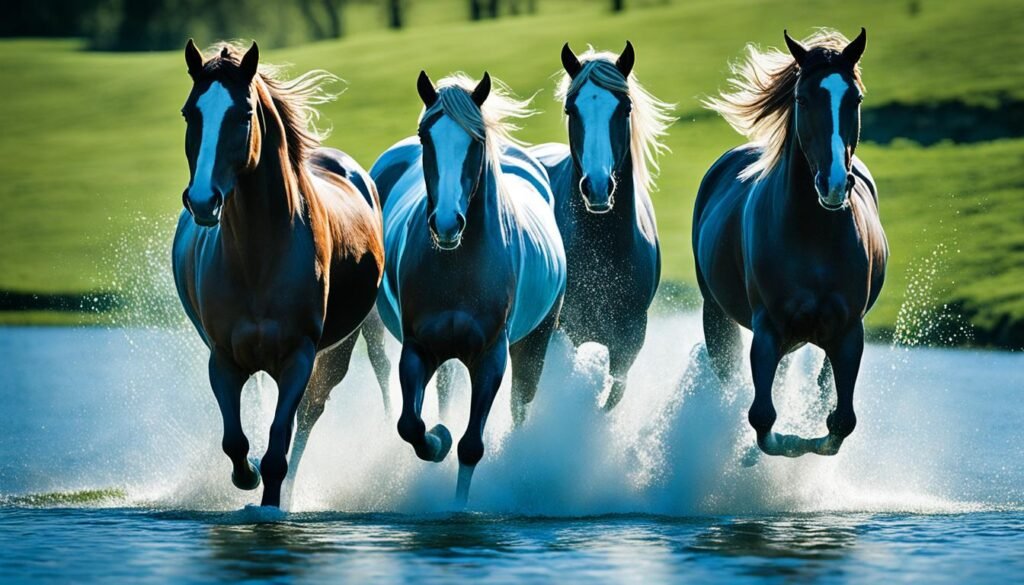In the captivating realm of equine research, a new frontier has emerged – the exploration of how underwater sounds and surface wave refraction influence the behavior and communication of horses.
This article delves into the fascinating intersection of Equine Acoustic Ecology, Underwater Acoustics, and Aquatic Bioacoustics, uncovering the intricate ways in which horses navigate their watery environments.
By understanding the principles of hydroacoustic signal processing and the factors that govern equine sound propagation, researchers can gain deeper insights into the complex interactions between horses and their aquatic habitats.
This knowledge not only enhances our understanding of equine behavior but also holds the potential to inform environmental acoustic sensing and animal communication monitoring methods.
Key Takeaways
- Exploration of how underwater sounds and surface wave refraction impact equine behavior and communication.
- Principles of aquatic bioacoustics and hydroacoustic signal processing in the study of equine acoustic ecology.
- Understanding the factors that influence equine sound propagation and their implications for environmental acoustic sensing.
- Innovative approaches to animal communication monitoring and challenges in equine behavior studies.
- Potential applications of equine acoustic ecology research in various fields, including environmental conservation and animal welfare.
Understanding Equine Acoustic Ecology
Delving into the captivating realm of Equine Acoustic Ecology, we unravel the significance of studying horse vocalization and the factors that shape the propagation of sound within the equine environment.
This specialized field offers a unique window into the complex communication dynamics of these majestic creatures.
Importance of Studying Horse Vocalization
Horse vocalizations are a rich tapestry of information, conveying a wealth of insights into the social, emotional, and behavioral aspects of equine life. By carefully analyzing these vocal cues, researchers can gain a deeper understanding of how horses interact, express their needs, and respond to their surroundings.
This knowledge is invaluable in enhancing equine welfare, training, and ultimately, our connection with these remarkable animals.
Factors Influencing Equine Sound Propagation
The propagation of sound within the equine habitat is influenced by a myriad of environmental factors, including vegetation, terrain, and the presence of water surfaces.
These elements can significantly impact the way sound travels, affecting the audibility and clarity of horse vocalizations. Studying these complex interactions is crucial in unraveling the intricacies of Equine Acoustic Ecology and how it shapes the communication and behavior of horses.
| Factor | Impact on Sound Propagation |
|---|---|
| Vegetation | Vegetation can absorb, reflect, and scatter sound waves, altering the propagation of horse vocalizations. |
| Terrain | Variations in terrain, such as hills and valleys, can create acoustic shadows and affect the directionality of sound. |
| Water Surfaces | Refractive properties of water surfaces can influence the behavior of sound waves, impacting the audibility and clarity of equine vocalizations. |
By understanding the complexities of Equine Acoustic Ecology, researchers can unlock valuable insights into the communication and behavior of horses, ultimately enhancing our ability to provide the best possible care and environment for these majestic animals.
Underwater Acoustics and Surface Wave Refraction
In the captivating realm of equine acoustic ecology, the principles of underwater acoustics and surface wave refraction play a crucial role.
This section delves into the intricacies of how sound propagates through aquatic environments and how the interplay between water surfaces and sound waves can significantly impact the soundscapes experienced by horses.
Underwater Acoustics: The propagation of sound in water differs vastly from its behavior in air. Water’s higher density and the presence of various dissolved substances create a unique acoustic environment.
Understanding the physics of underwater sound, including factors like absorption, reflection, and refraction, is essential for studying the acoustic ecology of equine habitats near or within water bodies.
| Acoustic Phenomenon | Description |
|---|---|
| Sound Absorption | The reduction in sound intensity as it travels through water, influenced by factors like temperature, salinity, and frequency. |
| Sound Reflection | The bouncing of sound waves off surfaces, such as the water’s surface or the seafloor, which can create echoes and multipath effects. |
| Sound Refraction | The bending of sound waves as they pass from one medium (e.g., air) to another (e.g., water), due to changes in speed of sound. |
Surface Wave Refraction: The interaction between sound waves and the water’s surface is particularly intriguing. As sound waves travel from air into water, or vice versa, they undergo refraction, causing the sound path to bend.
This phenomenon, known as surface wave refraction, can significantly alter the propagation of equine vocalizations, affecting their reach, directionality, and perceived intensity.

By understanding the principles of underwater acoustics and surface wave refraction, researchers can better comprehend the complex soundscapes that horses inhabit, ultimately shedding light on their acoustic ecology and communication strategies.
Equine Acoustic Ecology Through Refractive Water Surfaces
Exploring the intricate relationship between equine acoustic ecology and the refractive properties of water surfaces is a captivating field of study.
By delving into the principles of aquatic bioacoustics and the innovative hydroacoustic signal processing techniques, we can uncover the profound impact of water on horse vocalizations and communication.
Principles of Aquatic Bioacoustics
The behavior of sound waves as they traverse through water is a crucial aspect of aquatic bioacoustics. Factors such as water temperature, depth, and salinity can significantly influence the propagation and refraction of these underwater sound waves.
Understanding these principles is vital in deciphering how horses’ vocalizations are altered when they interact with refractive water surfaces, ultimately shaping their acoustic ecology.
Hydroacoustic Signal Processing Techniques
Advancements in hydroacoustic signal processing have enabled researchers to analyze the complex interplay between equine acoustic ecology and water surfaces.
By employing sophisticated techniques, such as spectral analysis, time-frequency representations, and beamforming, scientists can delve into the nuances of how water refracts and modifies horse vocalizations.
These analytical tools provide invaluable insights into the subtle ways in which the aquatic environment impacts equine communication and social behavior.
Through the integration of aquatic bioacoustics and hydroacoustic signal processing, we can unravel the intricate tapestry of equine acoustic ecology as it unfolds on refractive water surfaces.
This holistic approach empowers us to gain a deeper understanding of the complex interplay between horses and their watery habitats, ultimately informing more effective conservation and management strategies for these remarkable animals.
Animal Communication Monitoring
Studying animal communication, particularly in the context of equine behavior, presents unique challenges for researchers.
Horses, with their complex social structures and diverse vocalizations, offer a rich and fascinating field of exploration for acoustic ecologists and environmental acoustics experts.
Challenges in Equine Behavior Studies
Monitoring horse communication in their natural habitats can be a complex endeavor. Researchers must navigate a range of factors that can influence the propagation and detection of equine vocalizations, including:
- Varying terrain and vegetation, which can affect sound transmission
- Ambient noise from environmental sources, such as wind, weather, and other animals
- The dispersed and unpredictable nature of horse herds, making consistent observation difficult
- Individual differences in vocal behavior and communication patterns among horses
These challenges underscore the need for innovative approaches to animal communication monitoring, such as the application of hydroacoustic signal processing techniques and the integration of environmental acoustic sensing methods.
| Challenge | Impact on Equine Behavior Studies |
|---|---|
| Terrain and Vegetation | Sound transmission can be affected by factors like hills, trees, and other physical barriers, making it difficult to accurately detect and analyze equine vocalizations. |
| Ambient Noise | Environmental sounds, such as wind, weather, and other animals, can mask or interfere with the detection of horse vocalizations, requiring advanced noise reduction techniques. |
| Herd Dispersion | The scattered and unpredictable nature of horse herds makes it challenging to maintain consistent observation and data collection, limiting the depth of insights into their communication patterns. |
| Individual Differences | Variations in vocal behavior and communication styles among individual horses can complicate the interpretation of equine acoustic signals, necessitating comprehensive behavioral studies. |
By addressing these challenges through innovative monitoring techniques and interdisciplinary collaboration, researchers can unlock a deeper understanding of the rich acoustic ecology of the equine world, informing both scientific knowledge and practical applications in areas such as animal behavior studies and environmental conservation.

Environmental Acoustic Sensing
In the world of equine research, environmental acoustic sensing is emerging as a powerful tool for unraveling the complexities of equine acoustic ecology.
This advanced technology allows researchers to capture and analyze the intricate soundscapes that horses inhabit, providing insights into their communication, behavior, and interactions with their surroundings.
Applications in Equine Research
Environmental acoustic sensing offers a wealth of possibilities for equine researchers. By deploying specialized sensors and microphones, they can monitor the acoustic signatures of horses and their environments, revealing valuable information about:
- Equine vocalizations and their patterns
- Interactions between horses and their herd mates
- The impact of environmental factors on equine sound propagation
- The role of water surfaces in the acoustic ecology of equine habitats
This rich data can inform a deeper understanding of horse behavior, communication, and the complex interplay between animals and their acoustic surroundings.
As researchers continue to explore the applications of environmental acoustic sensing in equine research, they are unlocking new avenues for advancing the field of Acoustic Ecology and enhancing our knowledge of these majestic creatures.
| Application | Insights Gained |
|---|---|
| Equine Vocalizations | Patterns, intensity, and context of horse calls |
| Herd Dynamics | Interactions, social cues, and communication within equine groups |
| Environmental Factors | Impact of terrain, vegetation, and water surfaces on sound propagation |
| Acoustic Ecology | Understanding the role of sound in the overall ecosystem of equine habitats |
By harnessing the power of Environmental Acoustic Sensing, equine researchers are poised to unlock new dimensions of Equine Research and shed light on the intricate Acoustic Ecology that shapes the lives of these magnificent animals.
As the field continues to evolve, the insights gained from this innovative approach will undoubtedly contribute to our deeper Sound Monitoring and understanding of the equine world.
Analyzing Horse Vocalization Data
Studying horse vocalizations is a crucial aspect of equine acoustic ecology and bioacoustics research. By analyzing the rich data captured from horse sounds, researchers can gain valuable insights into animal communication patterns, social interactions, and individual animal identification.
One of the primary techniques used in analyzing horse vocalization data is acoustic signal processing. Researchers employ advanced digital signal processing algorithms to extract key features from horse vocalizations, such as pitch, amplitude, and spectral characteristics.
These data points can then be used to identify individual animals, understand the context of their calls, and even decipher the underlying meaning of their communication.
In addition to signal processing, researchers also leverage bioacoustic modeling to simulate and predict how horse vocalizations propagate through their environment.
By considering factors like terrain, vegetation, and weather conditions, researchers can better understand how acoustic signals are influenced by the surrounding habitat, ultimately enhancing their analysis of equine acoustic data.
| Analytical Technique | Application in Equine Vocalization Analysis |
|---|---|
| Acoustic Signal Processing | Extraction of pitch, amplitude, and spectral features to identify individual animals and understand communication patterns |
| Bioacoustic Modeling | Simulation of sound propagation through the equine habitat to contextualize vocalization data |
By combining these advanced analytical techniques, researchers can unlock a deeper understanding of horse vocalization and its role in the broader animal communication landscape.
This knowledge can inform conservation efforts, enhance equine behavior studies, and shed light on the intricate acoustic ecology of the equine world.
Surface Wave Refraction in Equine Habitats
In the realm of equine acoustic ecology, the impact of surface wave refraction on sound propagation is a critical factor to consider.
As sound waves interact with the dynamic water surfaces in equine habitats, they can undergo significant refraction, altering the way horses perceive and respond to their acoustic environment.
Impact on Acoustic Ecology
The intricate interplay between surface wave refraction and sound propagation can have profound implications for the acoustic ecology of equine communities. This phenomenon can influence the way horses communicate, perceive threats, and navigate their surroundings.
Understanding these complex dynamics is essential for researchers and equine enthusiasts alike to gain a comprehensive understanding of the acoustic landscape that horses inhabit.
| Factors Influencing Surface Wave Refraction | Impact on Equine Acoustic Ecology |
|---|---|
| Wind patterns Water depth and turbulence Substrate composition Ambient temperature and humidity | Altered sound localization and source identification Disruption of vocal communication and social interactions Changes in perception of predatory threats and environmental cues Potential impacts on herd dynamics and behavioral patterns |
By studying the intricacies of surface wave refraction and its impact on equine acoustic ecology, researchers can gain valuable insights into the complex relationship between horses and their acoustic environment.
This knowledge can inform conservation efforts, guide habitat management strategies, and enhance our overall understanding of the factors that shape the communication and behavior of these remarkable animals.
Equine Sound Propagation Modeling
Accurately modeling the propagation of equine sounds is crucial for researchers studying the complex dynamics of Equine Acoustic Ecology.
By simulating how sound waves travel and interact within equine habitats, experts can gain valuable insights into the factors that influence Acoustic Modeling and Bioacoustics.
One of the primary techniques employed in Environmental Acoustics is the use of ray tracing and wave propagation models. These computational methods allow researchers to predict the behavior of sound waves as they encounter various obstacles, surfaces, and atmospheric conditions within the equine environment.
This information can be used to identify optimal monitoring locations, understand the impacts of habitat changes, and ultimately, enhance our understanding of Equine Sound Propagation.
Additionally, advancements in signal processing and data analysis techniques have further empowered researchers to delve deeper into the nuances of equine vocalizations.
By coupling these analytical tools with Acoustic Modeling, scientists can uncover the complex interplay between environmental factors, animal behavior, and the transmission of sound within equine habitats. This holistic approach is essential for advancing the field of Equine Acoustic Ecology and informing conservation efforts.
FAQ
What is equine acoustic ecology and how does it relate to underwater acoustics?
Equine acoustic ecology is the study of how horses interact with their acoustic environment, particularly in relation to underwater sounds and surface wave refraction.
This field explores the principles of aquatic bioacoustics and hydroacoustic signal processing to understand how the watery environment impacts equine vocalizations and communication.
Why is it important to study horse vocalizations?
Analyzing horse vocalizations is crucial for understanding equine acoustic ecology. Vocalizations provide insights into individual horse behavior, social interactions, and communication patterns, which are essential for studying the complex relationship between horses and their acoustic environment.
What factors influence equine sound propagation?
Numerous factors can affect how sound propagates in the equine environment, including vegetation, terrain, and the presence of water surfaces. Understanding these factors is crucial for examining the impact of the aquatic environment on horse communication and behavior.
How do underwater acoustics and surface wave refraction impact equine acoustic ecology?
Underwater acoustics and surface wave refraction play a significant role in equine acoustic ecology. The interaction between sound waves and water surfaces can alter the way horses perceive and respond to their acoustic environment, influencing their overall communication and behavior.
What are the principles of aquatic bioacoustics, and how are they applied in equine research?
Aquatic bioacoustics focuses on the study of sound production, propagation, and perception in aquatic environments. These principles are applied in equine research to examine how horses interact with water surfaces and how this interaction affects their vocalizations and communication.
What are some of the challenges involved in monitoring animal communication, particularly in the context of equine behavior studies?
Monitoring animal communication, including equine vocalizations, presents several challenges. Factors such as environmental conditions, individual animal behavior, and technological limitations can make it difficult to accurately capture and analyze animal communication data.
How can environmental acoustic sensing be used in equine research?
Environmental acoustic sensing techniques can be valuable in equine research, as they allow researchers to capture and analyze the acoustic signatures of horses and their environments. These technologies can provide insights into equine acoustic ecology and help overcome some of the challenges associated with traditional monitoring methods.
What techniques are used to analyze horse vocalization data?
Researchers utilize various techniques to analyze horse vocalization data, such as identifying individual animals, understanding social interactions, and deciphering communication patterns. These techniques often involve bioacoustic signal processing and the use of specialized software and tools.
How does surface wave refraction impact equine acoustic ecology?
Surface wave refraction, the bending of sound waves as they interact with water surfaces, can significantly impact equine acoustic ecology. This phenomenon can alter the way horses perceive and respond to their acoustic environment, affecting their overall communication and behavior.
What is the importance of equine sound propagation modeling?
Equine sound propagation modeling is crucial for understanding the complex dynamics of equine acoustic ecology. By simulating and predicting how sound waves travel and interact within equine habitats, researchers can gain valuable insights into the relationship between horses and their acoustic environment.

